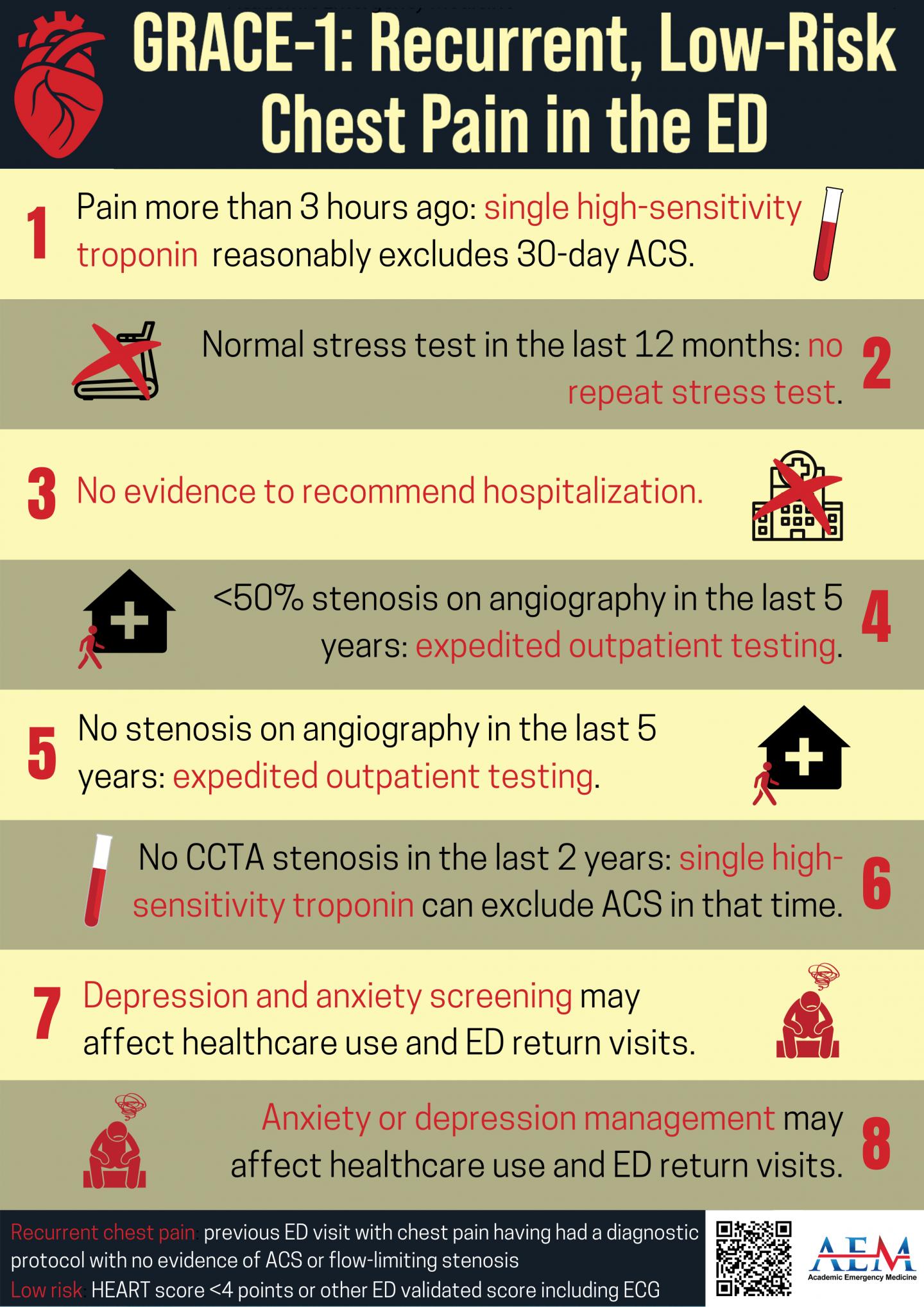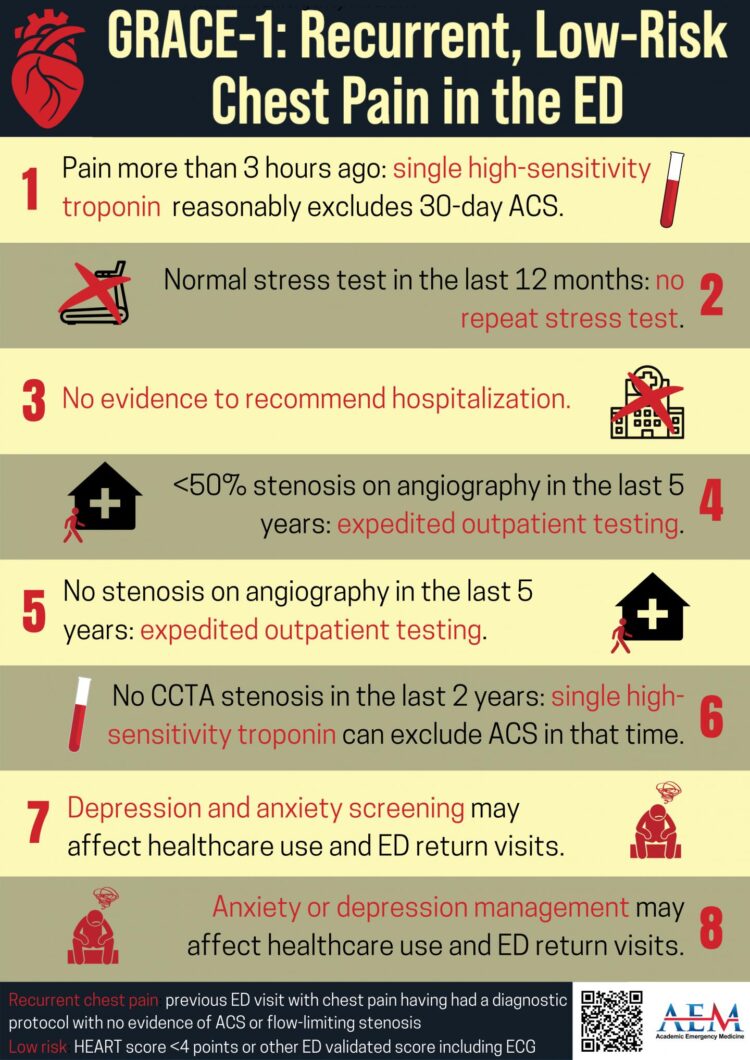GRACE: Guidelines for reasonable and appropriate care in the emergency department

Credit: KIRSTY CHALLEN, B.SC., MBCHB, MRES, PH.D., LANCASHIRE TEACHING HOSPITALS, UNITED KINGDOM
Des Plaines, IL – The Society for Academic Emergency Medicine (SAEM) is pleased to announce the release of the first publication in a series of Guidelines for Reasonable and Appropriate Care in the Emergency Department (GRACE), which focuses on low-risk chest pain. The article, titled “Guidelines for Reasonable and Appropriate Care in the Emergency Department (GRACE): Recurrent, Low-risk Chest Pain in the Emergency Department,” will be published in the July issue of SAEM’s peer reviewed journal, Academic Emergency Medicine (AEM).
Chest pain is the second most common chief complaint in the emergency department (ED), with only five percent of patients diagnosed with an acute, life-threatening condition. There are significant physician and institutional variations in diagnostic testing and admission of these patients, creating a need for clinical practice guidelines to aid in the evaluation and treatment specific to the ED population. The first SAEM GRACE team was assembled to address this critical need for evidence-based and expert-driven recommendations for the care of complaints associated with recurrent chest pain.
A multidisciplinary panel of experts assessed the certainty of evidence and strength of recommendations regarding eight priority questions for adults presenting to the ED with recurrent, low-risk chest pain. They then developed recommendations for testing, treatment, hospital admission, and screening tools and referrals for mental health management. To write this clinical practice guideline, the panel used Grading of Recommendations Assessment Development and Evaluation (GRADE) methodology, a framework for rating the quality of the best available evidence and developing clinical practice recommendations.
The lead author of the chest pain GRACE study is Paul Musey, Jr., MD, associate professor of emergency medicine in the department of emergency medicine at Indiana University School of Medicine in Indianapolis, Indiana.
In “GRACE-Recurrent Low Risk Chest Pain: A User’s Guide,” to be published alongside the GRACE study in the July issue of AEM, Courtney et al. summarize what emergency medicine physicians can take to the patient bedside and its possible effect in the ED,
“In patients with recurrent, low-risk chest pain and a normal stress test in the prior 12 months, it is not recommended to employ further routine stress testing to reduce subsequent 30-day Major Adverse Cardiac Events (MACE). In our opinion, the other important statement is that there is insufficient evidence to recommend hospitalization (either inpatient admission or observation) versus discharge as a strategy to mitigate 30-day MACE. Further recommendations including screening and referral for anxiety and depression, previously unexplored topics in the context of chest pain, should also be noted in this novel work.”
“Endorsement and dissemination by multi-stakeholder organizations and societies could catapult these recommendations into decision support within electronic health records and implementation for millions of chest pain visits across the US and beyond, transforming them into shared decision-making with patients at the point of care.”
The SAEM GRACE program addresses the best practices for the care of the most common chief complaints that can be seen on the tracking board of any emergency department in the country, based upon research and expert consensus. These guidelines are designed with de-implementation as a guiding principle to reasonably reduce wasteful testing, provide explicit criteria to reduce foreseeable risk, and define sensible and prudent medical care. In addition to GRACE for chest pain, SAEM research and writing teams will create guidelines for recurrent abdominal pain, acute dizziness, and non-opioid substance dependence.
In a commentary article, also in the July issue of AEM, titled “Navigating Uncertainty with GRACE: Society for Academic Emergency Medicine’s Guidelines for Reasonable and Appropriate Care in the Emergency Department,” Carpenter et al. further explain how and why GRACE guidelines were created,
“GRACE emerged to address the critical need for evidence-based and expert driven, trustworthy, and transparent recommendations for the clinical care of common chief complaints and syndromes, prioritizing those with demonstrable practice variability and significant malpractice angst that often elicit decisional conflict or treatment uncertainty.”
“It is vital for (emergency medicine) EM organizations to foster EM-specific guidelines, created by EM clinical/academic experts, to serve ED patient needs. GRACE will accelerate the creation of new evidence-based recommendations for our specialty, with involvement and focus on patient-important outcomes and consideration of patients’ values and preferences. Above all, GRACE aims to transparently report the decision process, as the focus on transparency facilitates understanding and implementation, and should empower patients and clinicians to make informed choices.”
###
ABOUT ACADEMIC EMERGENCY MEDICINE
Academic Emergency Medicine, the monthly journal of Society for Academic Emergency Medicine, features the best in peer-reviewed, cutting-edge original research relevant to the practice and investigation of emergency care. The above study is published open access and can be downloaded by following the DOI link: 10.1111/acem.14296. Journalists wishing to interview the authors may contact Tami Craig at [email protected].
ABOUT THE SOCIETY FOR ACADEMIC EMERGENCY MEDICINE
SAEM is a 501(c)(3) not-for-profit organization dedicated to the improvement of care of the acutely ill and injured patient by leading the advancement of academic emergency medicine through education and research, advocacy, and professional development. To learn more, visit saem.org.
Media Contact
Tami Craig
[email protected]
Related Journal Article
http://dx.





